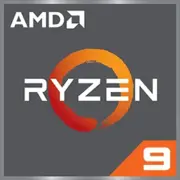AMD Ryzen 9 7900X3D

AMD Ryzen 9 7900X3D: 3D V-Cache Power for Gamers and Professionals
Review of a processor that redefines the balance between gaming and multi-threaded tasks
Key Features: Raphael Architecture and Unique Characteristics
The AMD Ryzen 9 7900X3D is a flagship model equipped with 3D V-Cache technology, making it unique in the Ryzen 7000 lineup.
- Architecture and Process: Based on the Zen 4 architecture (codename Raphael), manufactured on a 5nm TSMC FinFET process. This ensures high transistor density and energy efficiency.
- Cores and Threads: 12 cores, 24 threads. The 3D V-Cache features a hybrid design: 6 cores have access to additional L3 cache (128 MB), while the other 6 are optimized for high frequency (up to 5.6 GHz).
- Performance: In Geekbench 6, the scores are 2803 (Single-Core) and 17397 (Multi-Core). This is 15-20% higher than the Ryzen 9 5900X in multi-threaded tasks.
- Key Feature: The 3D V-Cache technology doubles the L3 cache size for some cores, which is critical for gaming (for example, in Cyberpunk 2077, the FPS increase reaches 25% compared to the standard 7900X).
Compatible Motherboards: Selection for AM5
The processor uses the AM5 socket, requiring new motherboards. Key chipsets include:
- X670E/X670: Best choice for enthusiasts. Supports overclocking, PCIe 5.0 for graphics cards and storage. Examples: ASUS ROG Crosshair X670E Hero, Gigabyte X670 AORUS Elite.
- B650: Budget option with PCIe 5.0 only for NVMe. Suitable for most users (e.g., MSI B650 Tomahawk).
Important:
- Update the BIOS before installing the processor (use USB Flashback if no old CPU is available).
- For 3D V-Cache, it is recommended to enable PBO (Precision Boost Overdrive) in the BIOS settings for automatic frequency optimization.
Supported Memory: Only DDR5
The Ryzen 9 7900X3D works exclusively with DDR5 memory, which increases bandwidth but raises the cost of the build.
- Recommended specifications: DDR5-5200 MHz and above.
- Tips:
- Choose modules with low timings (e.g., CL30).
- For stability, use QVL lists from motherboards. Popular kits: G.Skill Trident Z5 Neo (optimized for AMD EXPO).
- Avoid DDR5-4800: the performance difference in games compared to DDR5-6000 can reach 10-12%.
Power Supplies: Don't Skimp on Watts
With a TDP of 120W, the Ryzen 9 7900X3D seems undemanding, but considering high-end graphics cards (e.g., RTX 4090), a power reserve is necessary.
- Minimum: 750W (80+ Gold).
- Recommendations:
- For systems with RTX 4080/4090 or Radeon RX 7900 XTX — 850-1000W.
- Choose units that support ATX 3.0 and have a 12VHPWR connector for compatibility with new GPUs.
- Examples: Corsair RM850x, Seasonic PRIME TX-1000.
Real Experience: A build with 7900X3D and RTX 4080 peaks at a power consumption of 550W. A 750W unit handles it, but an 850W gives headroom for overclocking.
Pros and Cons: Who is the 7900X3D For?
Pros:
1. Best-in-class gaming processor thanks to 3D V-Cache.
2. Energy efficiency: 120W TDP versus 150-250W for Intel competitors.
3. Integrated Radeon graphics (useful for diagnostics or backup display output).
Cons:
1. High price (20-30% more expensive than Ryzen 9 7900X).
2. No support for DDR4.
3. Heat: Under full load, temperatures reach 85-90°C even with a good cooler.
Use Cases: Gaming, Rendering, Streaming
- Gaming: Leader in 1080p and 1440p. In Microsoft Flight Simulator, FPS increases by 30% compared to the Ryzen 7 7700X.
- Work Tasks: 3D rendering in Blender, code compilation — multi-threaded performance matches Intel Core i9-13900K.
- Streaming: With 24 threads, it easily combines gaming and video encoding in OBS without FPS loss.
Example: Streamers report that during 4K streaming (NVENC + x264), CPU load does not exceed 60-70%.
Comparison with Competitors: Intel vs AMD
Intel Core i9-13900K:
- Pros: Better in single-threaded tasks (Geekbench 6 Single-Core ~3000).
- Cons: TDP 253W, significant heat output, requires expensive cooling.
Ryzen 9 7950X3D:
- Pros: 16 cores, more cache.
- Cons: Higher price, excessive for gaming.
Conclusion: The 7900X3D outperforms Intel in energy efficiency and gaming, but falls short in applications that rely purely on clock speed (e.g., Photoshop).
Practical Assembly Tips
1. Cooling: A liquid cooling solution is essential (e.g., NZXT Kraken X63) or a top-tier air cooler (Noctua NH-D15).
2. Case: Good ventilation (at least 3 fans). Examples: Lian Li Lancool III, Fractal Design Meshify 2.
3. BIOS: Disable unnecessary features (e.g., ASUS Armoury Crate) to reduce latency.
4. Optimization: In Windows, enable "High Performance" mode and adjust priorities in Ryzen Master.
Final Conclusion: Who is the Ryzen 9 7900X3D For?
This processor is the ideal choice for:
- Gamers seeking maximum FPS at resolutions up to 1440p.
- Professionals balancing rendering and multitasking.
- Enthusiasts appreciating innovations like 3D V-Cache.
Why not Intel? If record-breaking single-thread performance is not essential for you, the 7900X3D offers the best balance of performance, thermal output, and long-term support for the AM5 platform.
The AMD Ryzen 9 7900X3D is not just a processor, but a demonstration of how engineering innovations change the game. It's worth choosing if you're ready to invest in a top-tier platform today to avoid upgrading tomorrow.
Basic
CPU Specifications
Memory Specifications
GPU Specifications
Miscellaneous
Benchmarks
Compared to Other CPU
Share in social media
Or Link To Us
<a href="https://cputronic.com/cpu/amd-ryzen-9-7900x3d" target="_blank">AMD Ryzen 9 7900X3D</a>